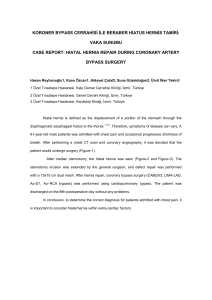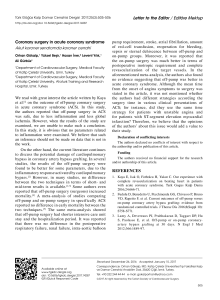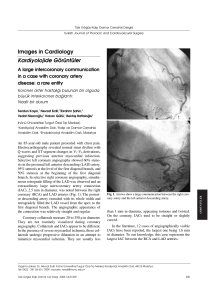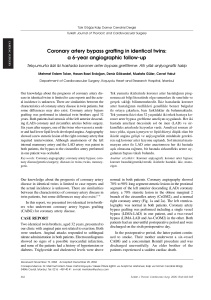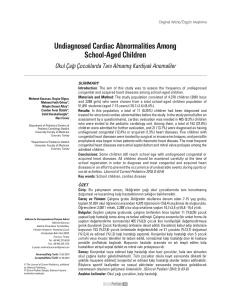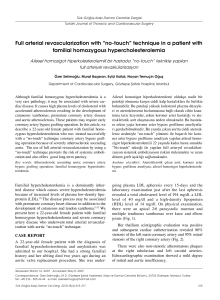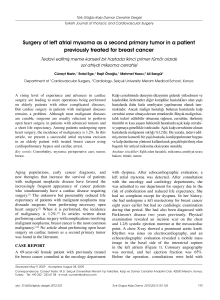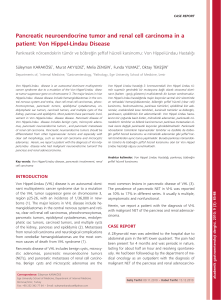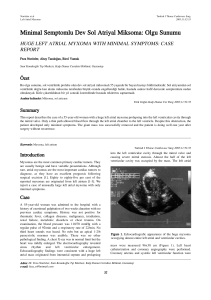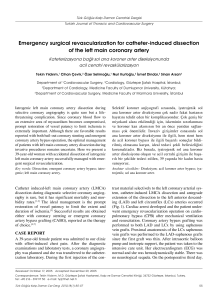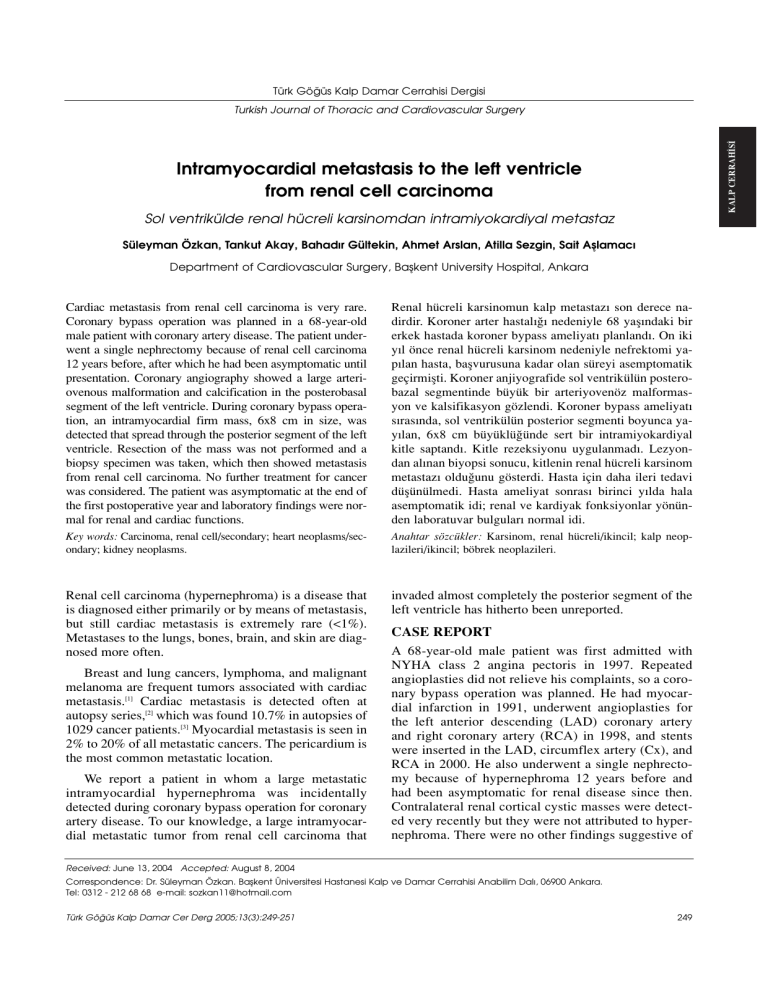
Türk Gö¤üs Kalp Damar Cerrahisi Dergisi
KALP CERRAH‹S‹
Turkish Journal of Thoracic and Cardiovascular Surgery
Intramyocardial metastasis to the left ventricle
from renal cell carcinoma
Sol ventrikülde renal hücreli karsinomdan intramiyokardiyal metastaz
Süleyman Özkan, Tankut Akay, Bahad›r Gültekin, Ahmet Arslan, Atilla Sezgin, Sait Afllamac›
Department of Cardiovascular Surgery, Baflkent University Hospital, Ankara
Cardiac metastasis from renal cell carcinoma is very rare.
Coronary bypass operation was planned in a 68-year-old
male patient with coronary artery disease. The patient underwent a single nephrectomy because of renal cell carcinoma
12 years before, after which he had been asymptomatic until
presentation. Coronary angiography showed a large arteriovenous malformation and calcification in the posterobasal
segment of the left ventricle. During coronary bypass operation, an intramyocardial firm mass, 6x8 cm in size, was
detected that spread through the posterior segment of the left
ventricle. Resection of the mass was not performed and a
biopsy specimen was taken, which then showed metastasis
from renal cell carcinoma. No further treatment for cancer
was considered. The patient was asymptomatic at the end of
the first postoperative year and laboratory findings were normal for renal and cardiac functions.
Renal hücreli karsinomun kalp metastaz› son derece nadirdir. Koroner arter hastal›¤› nedeniyle 68 yafl›ndaki bir
erkek hastada koroner bypass ameliyat› planland›. On iki
y›l önce renal hücreli karsinom nedeniyle nefrektomi yap›lan hasta, baflvurusuna kadar olan süreyi asemptomatik
geçirmiflti. Koroner anjiyografide sol ventrikülün posterobazal segmentinde büyük bir arteriyovenöz malformasyon ve kalsifikasyon gözlendi. Koroner bypass ameliyat›
s›ras›nda, sol ventrikülün posterior segmenti boyunca yay›lan, 6x8 cm büyüklü¤ünde sert bir intramiyokardiyal
kitle saptand›. Kitle rezeksiyonu uygulanmad›. Lezyondan al›nan biyopsi sonucu, kitlenin renal hücreli karsinom
metastaz› oldu¤unu gösterdi. Hasta için daha ileri tedavi
düflünülmedi. Hasta ameliyat sonras› birinci y›lda hala
asemptomatik idi; renal ve kardiyak fonksiyonlar yönünden laboratuvar bulgular› normal idi.
Key words: Carcinoma, renal cell/secondary; heart neoplasms/secondary; kidney neoplasms.
Anahtar sözcükler: Karsinom, renal hücreli/ikincil; kalp neoplazileri/ikincil; böbrek neoplazileri.
Renal cell carcinoma (hypernephroma) is a disease that
is diagnosed either primarily or by means of metastasis,
but still cardiac metastasis is extremely rare (<1%).
Metastases to the lungs, bones, brain, and skin are diagnosed more often.
invaded almost completely the posterior segment of the
left ventricle has hitherto been unreported.
Breast and lung cancers, lymphoma, and malignant
melanoma are frequent tumors associated with cardiac
metastasis.[1] Cardiac metastasis is detected often at
autopsy series,[2] which was found 10.7% in autopsies of
1029 cancer patients.[3] Myocardial metastasis is seen in
2% to 20% of all metastatic cancers. The pericardium is
the most common metastatic location.
We report a patient in whom a large metastatic
intramyocardial hypernephroma was incidentally
detected during coronary bypass operation for coronary
artery disease. To our knowledge, a large intramyocardial metastatic tumor from renal cell carcinoma that
CASE REPORT
A 68-year-old male patient was first admitted with
NYHA class 2 angina pectoris in 1997. Repeated
angioplasties did not relieve his complaints, so a coronary bypass operation was planned. He had myocardial infarction in 1991, underwent angioplasties for
the left anterior descending (LAD) coronary artery
and right coronary artery (RCA) in 1998, and stents
were inserted in the LAD, circumflex artery (Cx), and
RCA in 2000. He also underwent a single nephrectomy because of hypernephroma 12 years before and
had been asymptomatic for renal disease since then.
Contralateral renal cortical cystic masses were detected very recently but they were not attributed to hypernephroma. There were no other findings suggestive of
Received: June 13, 2004 Accepted: August 8, 2004
Correspondence: Dr. Süleyman Özkan. Baflkent Üniversitesi Hastanesi Kalp ve Damar Cerrahisi Anabilim Dal›, 06900 Ankara.
Tel: 0312 - 212 68 68 e-mail: [email protected]
Türk Gö¤üs Kalp Damar Cer Derg 2005;13(3):249-251
249
Özkan et al. Intramyocardial metastasis to the left ventricle from renal cell carcinoma
CARDIAC SURGERY
metastasis. Creatinin clearance was 53 ml/min and
renal function tests were normal. Electrocardiography
recordings at D2, D3 and aVF revealed T-wave inversions and pathological Q-waves suggesting a previous
inferior myocardial infarction. Transthoracic echocardiography showed posterobasal akinesia with normal
valve functions and normal heart chambers. Coronary
angiography showed critical in-stent LAD occlusion
and lesions in the RCA and obtuse marginal branch of
the Cx. A large arteriovenous malformation and calcification in the posterobasal segment of the left ventricle were also noted (Fig. 1a). The posterobasal segment was hypokinetic.
During coronary bypass operation for the LAD,
Cx, and RCA, an intramyocardial mass was observed
that spread through the posterior segment of the left
ventricle. The mass was very stiff and 6x8 cm in size,
causing an upward shift in the acute margin of the
right ventricle. It was difficult to distinguish its margins from the normal myocardial tissue. Resection of
the mass was not performed and a biopsy specimen
was taken, which then showed metastasis from hypernephroma. He was weaned from cardiopulmonary
bypass easily and was discharged on the ninth postoperative day. No further treatment for cancer was
considered. The patient was asymptomatic within the
first postoperative year, and laboratory findings were
normal for renal and cardiac functions. Thorax computed tomography showed a right pleural effusion and
small-sized lung metastasis in the second postoperative year, but no further cardiac metastasis could be
determined other than the preexisting large mass and
collateral arteriovenous malformation detected by
angiography (Fig. 1b).
(a)
DISCUSSION
Cardiac metastasis from hypernephroma was incidentally detected in our patient during coronary bypass
operation. Renal cell carcinoma mostly invades the
renal vein and even extend into the inferior vena cava
and presents as a pulmonary embolus and a mass in
the right atrium. Although similar cases have been
reported, asymptomatic intramyocardial late cardiac
metastasis from renal cell carcinoma is very rare in the
literature. Bradley and Bolling[4] reported a case with
renal cell carcinoma metastasis to the left ventricular
outflow tract. However, a large metastatic mass from
renal cell carcinoma invading almost completely the
posterior segment of the left ventricle has not been
reported.
There are no specific clinical symptoms and laboratory findings for cardiac metastases in cancer patients.
Electrocardiographic changes are nonspecific; arrhythmias, low voltage complexes, nonspecific ST-T-segment
modifications may occur. Occasionally, cardiac metastasis may imitate myocardial infarction with ST-segment
elevation.[5,6] The incidence of supraventricular arrhythmias is higher in cancer patients with cardiac metastasis.[2]
The onset of a murmur, pericardial pain or rub, effusion,
arrhythmia, or ECG changes in a patient with a previous
diagnosis of a malignancy should arouse suspicion of a
cardiac metastasis. The tumor was unresectable in our
case, but fortunately the patient was asymptomatic and
could be weaned from coronary bypass operation.
Cardiac metastasis can affect the surgical approach,
technique, and the extensiveness of surgery. These
metastatic masses may be resected by cardiopulmonary
bypass to prevent pulmonary emboli and circulatory dis-
(b)
Fig. 1. (a) Coronary angiogram showing a large arteriovenous malformation in the posterobasal segment of the left
ventricle. (b) No further cardiac metastasis could be determined by thorax computed tomography in the second postoperative year.
250
Turkish J Thorac Cardiovasc Surg 2005;13(3):249-251
turbances. However, the effect of cardiopulmonary
bypass on tumor extension and the outcome is not known.
Polascik et al.[7] showed that five-year survival rates were
nearly the same in cases of hypernephroma with only
intracaval extension or right atrial invasion, both being
below 5%. In case of disseminated metastatic disease
involving the heart and great vessels, coronary artery
revascularization methods may be modified. A high risk
for mortality may exclude surgical revascularization and
nonsurgical myocardial revascularization techniques can
be used. Thorax computed tomography may not be helpful to determine metastasis from hypernephroma.
Asymptomatic patients with a diagnosis of a previous
malignancy should be investigated more extensively with
respect to metastasis to the heart and other vital organs.
REFERENCES
1. Hall RJ, Cooley DA, McAllister HA Jr, Frazier OH.
Neoplastic heart disease. In: Schlant RC, Alexander RW, edi-
Türk Gö¤üs Kalp Damar Cer Derg 2005;13(3):249-251
2.
3.
4.
5.
6.
7.
tors. Hurst’s the heart, arteries and veins. 8th ed. New York:
McGraw-Hill; 1994. p. 2007-29.
Tamura A, Matsubara O, Yoshimura N, Kasuga T, Akagawa S,
Aoki N. Cardiac metastasis of lung cancer. A study of metastatic pathways and clinical manifestations. Cancer 1992;
70:437-42.
Klatt EC, Heitz DR. Cardiac metastases. Cancer 1990;65:
1456-9.
Bradley SM, Bolling SF. Late renal cell carcinoma metastasis to the left ventricular outflow tract. Ann Thorac Surg
1995;60:204-6.
Astorri E, Bonetti A, Fiorina P. ECG mimicking acute
myocardial infarction during heart involvement by lung neoplasm. Int J Cardiol 2000;74:225-6.
Houghton JL, Sinden JR, Gross CM. Case report: acute presentation of pseudo myocardial infarction secondary to
metastatic cancer. Am J Med Sci 1992;303:170-3.
Polascik TJ, Partin AW, Pound CR, Marshall FF. Frequent
occurrence of metastatic disease in patients with renal cell
carcinoma and intrahepatic or supradiaphragmatic intracaval
extension treated with surgery: an outcome analysis. Urology
1998;52:995-9.
251
KALP CERRAH‹S‹
Özkan ve ark. Sol ventrikülde renal hücreli karsinomdan intramiyokardiyal metastaz

